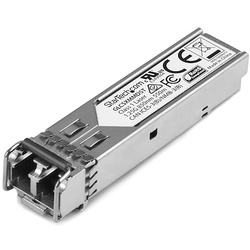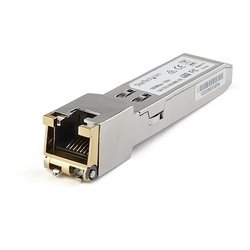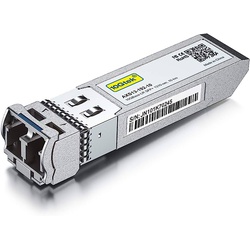
Cisco GLC-LH-SMD Gigabit SFP transceiver module, MMF/SMF Multimode & SingleMode
by Cisco
The Cisco GLC-LH-SMD Gigabit SFP transceiver module is designed to support both multimode and single-mode fibers. It is compatible with the IEEE 802.3z 1000BASE-LX standard and operates at a wavelength of 1300 nm.
- Compatibility: It is compatible with the IEEE 802.3z 1000BASE-LX standard, ensuring interoperability with various networking devices and equipment.
- Fiber Support: The module supports both multimode and single-mode fibers, making it versatile for different network environments.
- Reach: When used with single-mode fiber, the module can achieve link spans of up to 10 kilometers, enabling long-distance connections. On multimode fibers, it supports a maximum reach of 550 meters.
- Mode Conditioning: When connected to legacy multimode fiber, the transmitter should be coupled through a mode conditioning patch cable to ensure optimal performance.
- Wavelength: The module operates at a 1300-nanometer (nm) wavelength, which is commonly used for fiber optic transmission in the LX/LH range.
- Temperature Range: It features an extended operating temperature range, allowing it to operate reliably in varying environmental conditions.
| SKU | 1243 |
|---|
Reviews
This product does not have any reviews yet.
Add your reviewDescription
Cisco GLC-LH-SMD Gigabit SFP transceiver module, MMF/SMF Multimode & SingleMode
The Cisco GLC-LH-SMD Gigabit SFP transceiver module is designed to support both multimode and single-mode fibers. It is compatible with the IEEE 802.3z 1000BASE-LX standard and operates at a wavelength of 1300 nm.
When used with single-mode fiber, the GLC-LH-SMD can achieve link spans of up to 10 kilometers. It can also operate on multimode fibers with a maximum reach of 550 meters. However, when connecting to legacy multimode fiber, a mode conditioning patch cable is required to ensure proper coupling of the transmitter.
The GLC-LH-SMD module features an extended operating temperature range, allowing it to function in various environmental conditions. It also supports Digital Optical Monitoring (DOM), which provides real-time monitoring of key parameters such as optical power, temperature, and transceiver voltage.
For connectivity, the GLC-LH-SMD module utilizes dual LC/PC connectors, which are common in fiber optic networks. These connectors provide a reliable and efficient connection between the transceiver module and the network equipment.
Overall, the Cisco GLC-LH-SMD Gigabit SFP transceiver module is a versatile and high-performance solution for both multimode and single-mode fiber networks, offering extended reach, temperature tolerance, and monitoring capabilities.
Key features:
Compatibility: It is compatible with the IEEE 802.3z 1000BASE-LX standard, ensuring interoperability with various networking devices and equipment.
-
Fiber Support: The module supports both multimode and single-mode fibers, making it versatile for different network environments.
-
Reach: When used with single-mode fiber, the module can achieve link spans of up to 10 kilometers, enabling long-distance connections. On multimode fibers, it supports a maximum reach of 550 meters.
-
Mode Conditioning: When connected to legacy multimode fiber, the transmitter should be coupled through a mode conditioning patch cable to ensure optimal performance.
-
Wavelength: The module operates at a 1300-nanometer (nm) wavelength, which is commonly used for fiber optic transmission in the LX/LH range.
-
Temperature Range: It features an extended operating temperature range, allowing it to operate reliably in varying environmental conditions.
-
Digital Optical Monitoring (DOM) Support: The GLC-LH-SMD module supports DOM, providing real-time monitoring of key parameters such as optical power, temperature, and transceiver voltage. This enables enhanced network management and troubleshooting capabilities.
-
Connector: The module utilizes dual LC/PC connectors, which are standard connectors used in fiber optic networks. These connectors provide a reliable and efficient connection between the module and the networking equipment.



